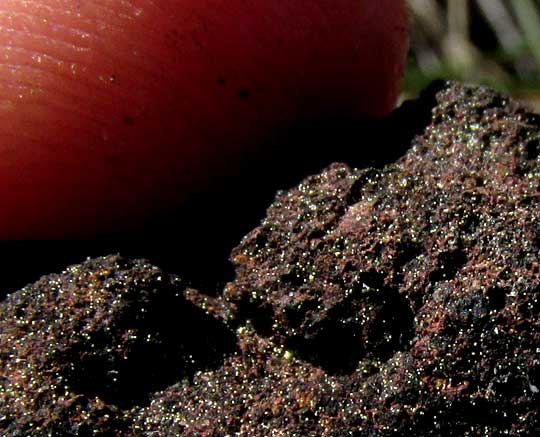Excerpts from Jim Conrad's
Naturalist Newsletter
notes from the May 3, 2015 Newsletter describing a camping trip in the forest south of Las Vigas in northern Veracruz, México
BASALT

At Reserva San Juan del Monte walking through the forest isn't easy because in many places the basaltic rock forming the bedrock is exposed in jaggedly irregular forms. Often the basalt contains holes covered with grass so when you step there your leg gets swallowed and you lose some skin. Above, you can see a rock of basalt, typically black and with the texture of frozen grits.
Below, a close-up of the above rock, with ridges on my fingertips providing scale, reveals tiny, white thingies embedded in the black rock matrix, with larger splotches of dark reddish rustiness here and there:

Basalt is the most abundant of the planet's bedrocks, though over very large areas you can't find it locally; I never saw basalt in Kentucky. That's because basalt is of igneous origin, typically associated with volcanic activities, and Kentucky's landscape is developed atop sedimentary rock, especially limestone, sandstone, and sediment itself. The Reserve's basalt has formed from ancient lava issued from Cofre de Perote Volcano.
Basalt starts out as gravy-like volcanic magma or lava at or near the landscape's surface. Its position at or near the surface is important, because there it cools relatively fast -- so fast that mineral compounds in the molten magma or lava don't have time to form large crystals. Magma that cools deep within the earth may cool for centuries, during which time its constituent mineral compounds have the time to coalesce and solidify into large, sometimes gigantic crystals. The resulting rock bearing large crystals may have the same mineral composition as our basalt, but its texture will be very different, and so, by definition, won't be basalt. A rock with the same chemical composition as our basalt at Las Vigas, but with a coarser texture, would be called gabbro.
Basalt does contain crystals, but they're so tiny that the naked eye can't make them out. Or maybe they're just barely visible, which is the case in our close-up, where the tiny, white objects are either microscopic white minerals or reflective crystal faces.
If erupted lava lands in water where it cools very rapidly, then the lava's mineral compounds don't even have time to make microscopic crystals. The magma freezes into something like glass with no or very little crystaline structure at all. Such rock, usually black, is called obsidian.
Basalt rock contains a fair amount of iron, so the rusty-red stains on our rock close-up are simply areas with higher concentrations of iron that has rusted when exposed to the air. When something rusts, its iron atoms combine with oxygen atoms to form iron oxide, which is rust.
Identifying a rock type can be a tricky business, especially because there are no strict boundaries between rock types. For example, there's limestone and there's shale, and there's limy shale, and all gradations between them. It's the same way with basalt. I knew to call the black rock at Las Vigas basalt because we were in a volcanic area, the rock type most to be expected in such areas is basalt, and our rock had the color and texture of basalt I'd seen elsewhere.
More technically, the definition of basalt is that it's an igneous rock of a certain fine texture (frozen grits) composed of less than 20% quartz and less than 10% feldspar by volume, and with at least 65% of its feldspar in the form of plagioclase.